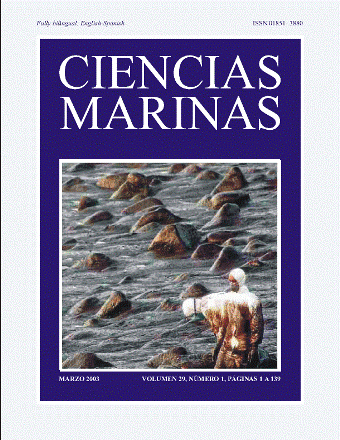Geographic variability of the concentration of Hg, Co, Fe and Ni in mussels Mytilus californianus (Conrad, 1837) from the coast of Baja California
Main Article Content
Abstract
The spatial distribution of the Hg, Fe, Co, and Ni pollution was determined in the Northwest coast of Baja California using the mussel Mytilus californianus as biomonitor. Samplings of mussels were done during February and July 1994 at eight sites located along 300 km of coast, from Punta Bandera (10 km south of the Mexico-USA border) to San Quintin (300 km south of the border). The spatial distribution of Hg showed a North-South gradient from Punta Bandera (0.331 µg g–1) to San Quintin (0.094 µg g–1). This gradient suggests that the Hg distribution is affected by anthropogenic activities nearby the Mexico-USA border. Cobalt showed a spatial distribution with significantly higher concentrations (P < 0.01) in Piedra Blanca (2.98 µg g–1) and San Quintin (2.26 µg g–1). Nickel showed an irregular spatial distribution with higher concentrations in Punta Bandera (2.07 µg g–1) and San Quintin (1.83 µg g–1). In general, Fe showed higher concentrations from Punta Bandera to Bajamar in February (515–504 µg g–1); except for Punta China (1142 µg g–1) that is characterized by the extraction of petrous material for the cement industry, the sampling sites in the central part of the study area showed lower concentrations. No significant correlations were observed among metals and the biological variables of the analyzed mussels. The cluster analysis among metals, grouped Hg with elements (Ag and Pb) associated with anthropogenic activities in a previous study. Cluster analysis showed three geographical zones that could be defined as polluted, transition and clean zone, respectively.
Downloads
Article Details
This is an open access article distributed under a Creative Commons Attribution 4.0 License, which allows you to share and adapt the work, as long as you give appropriate credit to the original author(s) and the source, provide a link to the Creative Commons license, and indicate if changes were made. Figures, tables and other elements in the article are included in the article’s CC BY 4.0 license, unless otherwise indicated. The journal title is protected by copyrights and not subject to this license. Full license deed can be viewed here.

